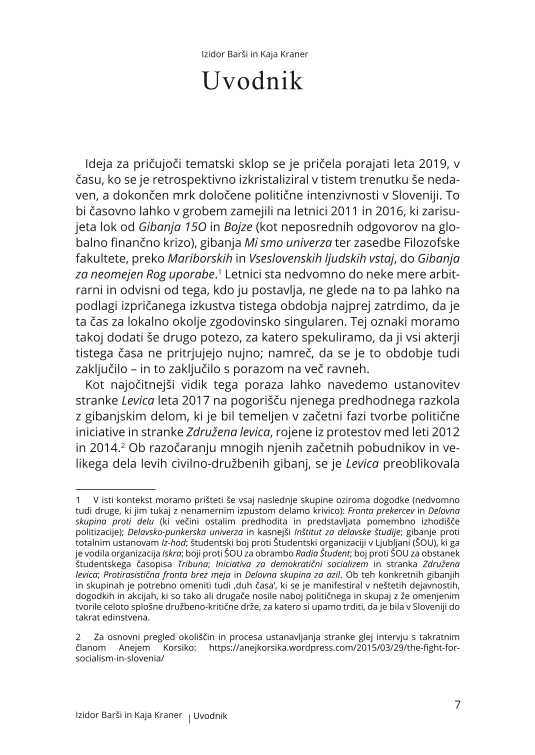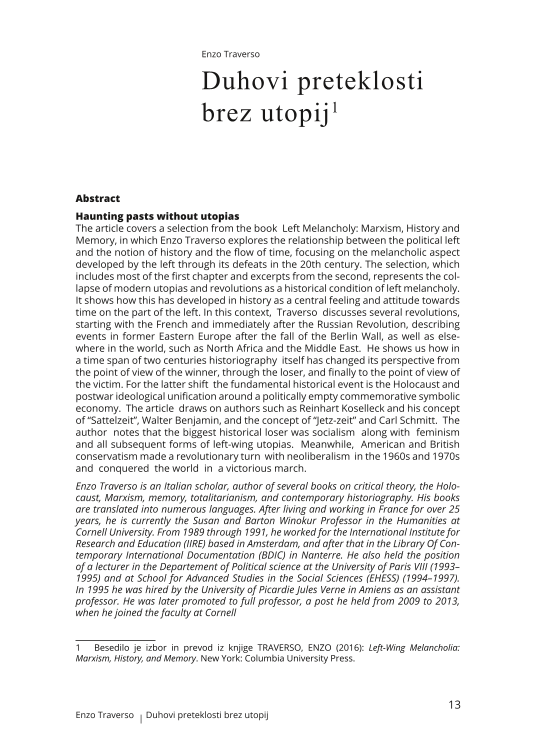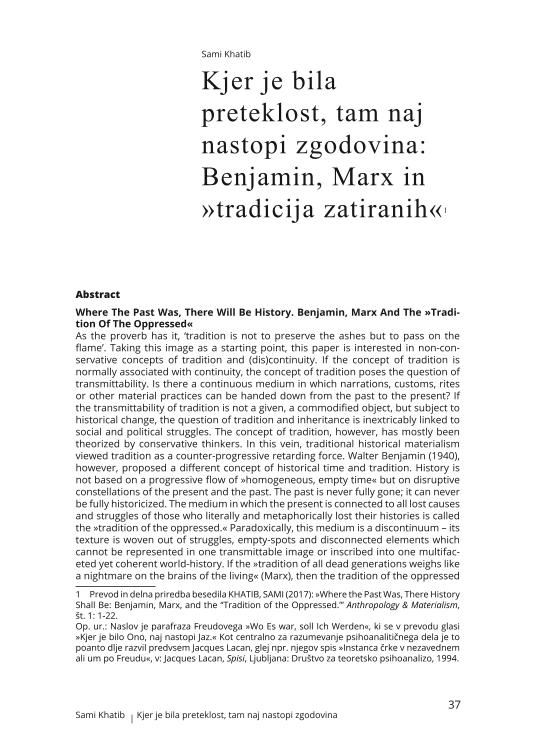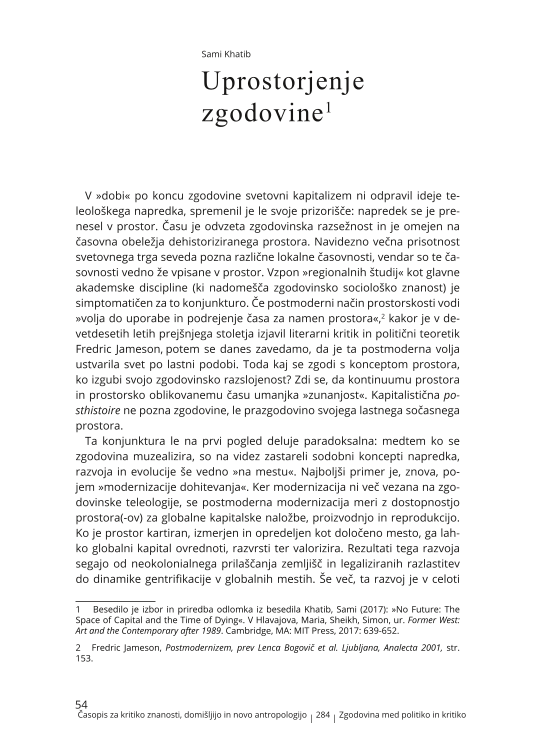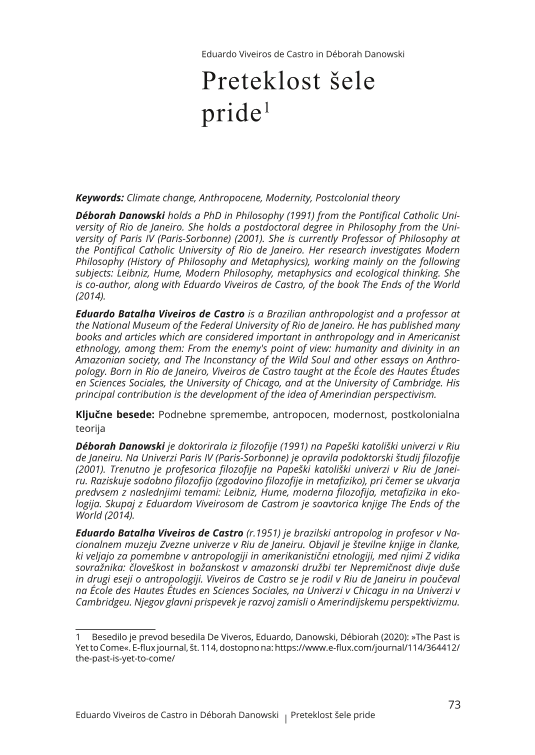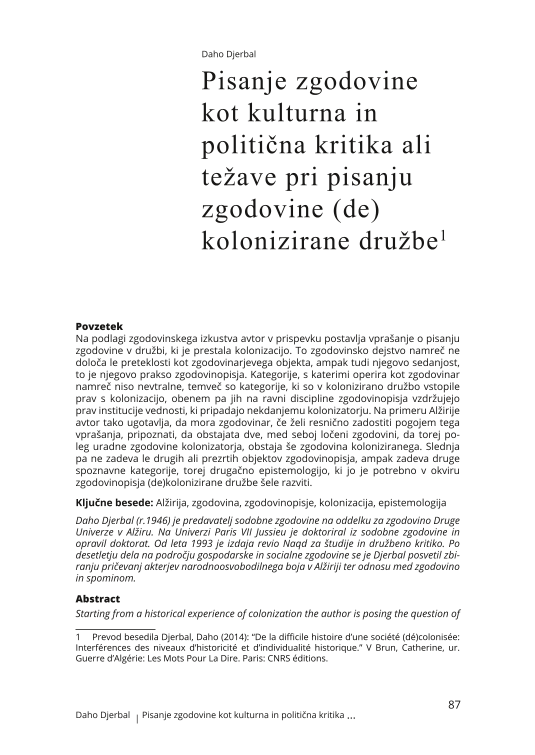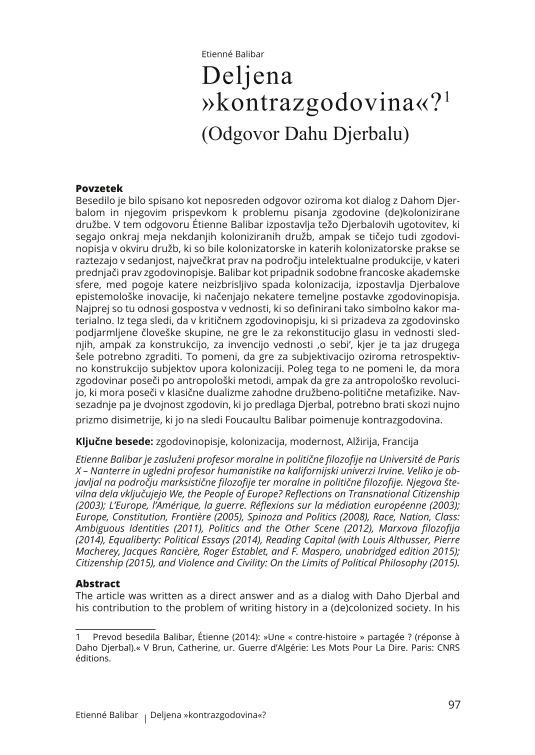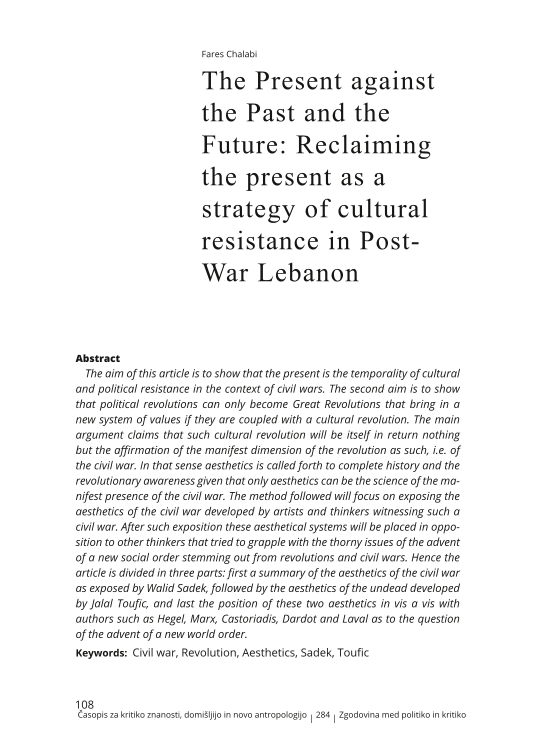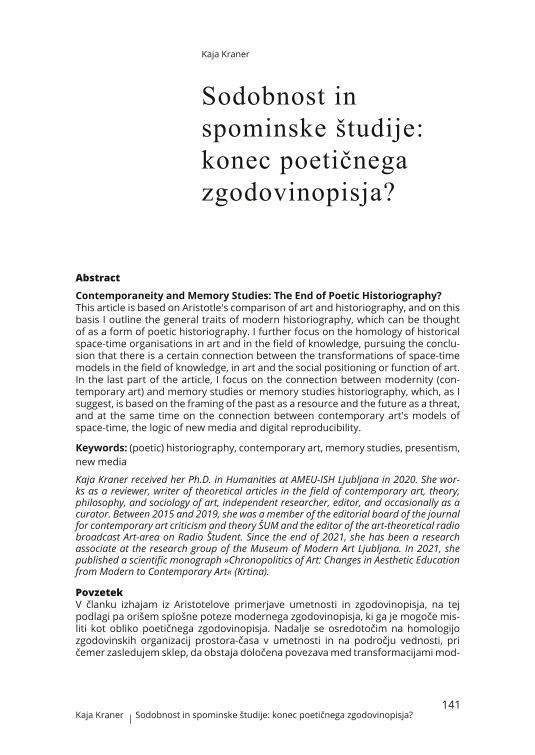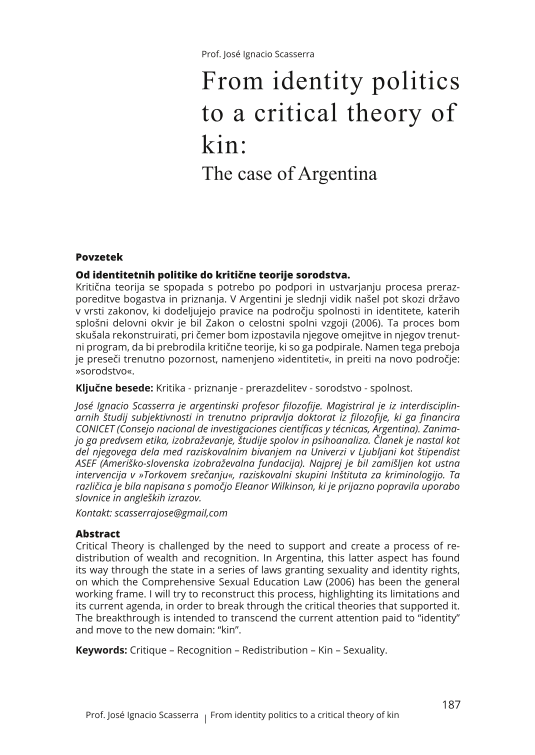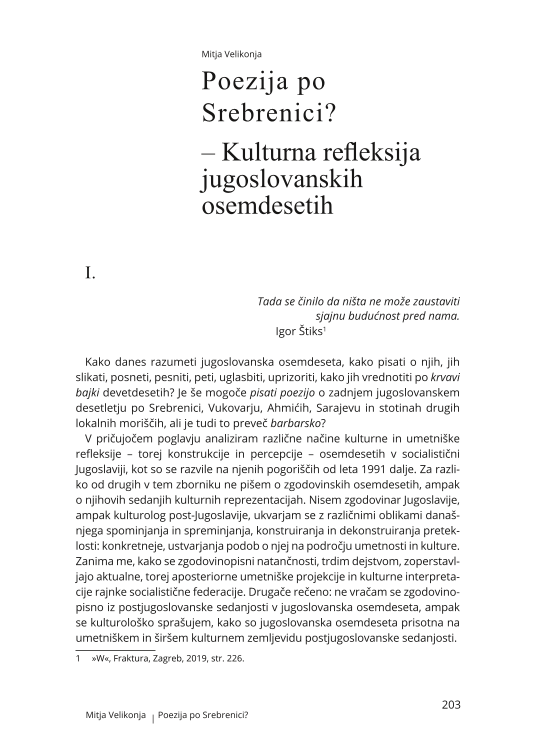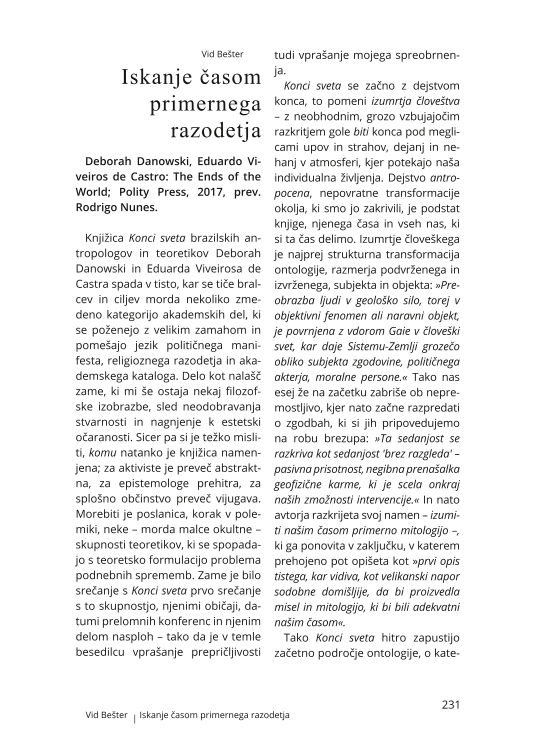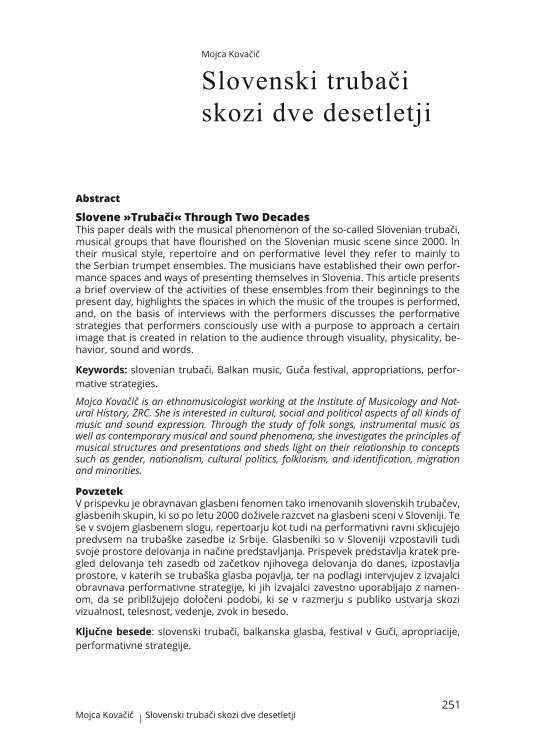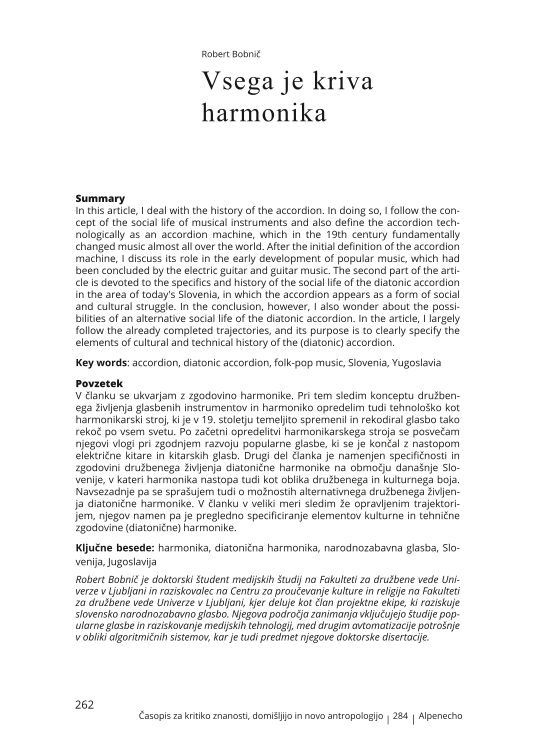Ideja za pričujoči tematski sklop se je pričela porajati leta 2019, v času, ko se je retrospektivno izkristaliziral v tistem trenutku še nedaven, a dokončen mrk določene politične intenzivnosti v Sloveniji. To bi časovno lahko v grobem zamejili na letnici 2011 in 2016, ki zarisujeta lok od Gibanja 15O in Bojze (kot neposrednih odgovorov na globalno finančno krizo), gibanja Mi smo univerza ter zasedbe Filozofske fakultete, preko Mariborskih in Vseslovenskih ljudskih vstaj, do Gibanja za neomejen Rog uporabe.1 Letnici sta nedvomno do neke mere arbitrarni in odvisni od tega, kdo ju postavlja, ne glede na to pa lahko na podlagi izpričanega izkustva tistega obdobja najprej zatrdimo, da je ta čas za lokalno okolje zgodovinsko singularen. Tej oznaki moramo takoj dodati še drugo potezo, za katero spekuliramo, da ji vsi akterji tistega časa ne pritrjujejo nujno; namreč, da se je to obdobje tudi zaključilo – in to zaključilo s porazom na več ravneh.
The article covers a selection from the book Left Melancholy: Marxism, History and Memory, in which Enzo Traverso explores the relationship between the political left and the notion of history and the flow of time, focusing on the melancholic aspect developed by the left through its defeats in the 20th century. The selection, which includes most of the first chapter and excerpts from the second, represents the collapse of modern utopias and revolutions as a historical condition of left melancholy. It shows how this has developed in history as a central feeling and attitude towards time on the part of the left. In this context, Traverso discusses several revolutions, starting with the French and immediately after the Russian Revolution, describing events in former Eastern Europe after the fall of the Berlin Wall, as well as elsewhere in the world, such as North Africa and the Middle East. He shows us how in a time span of two centuries historiography itself has changed its perspective from the point of view of the winner, through the loser, and finally to the point of view of the victim. For the latter shift the fundamental historical event is the Holocaust and postwar ideological unification around a politically empty commemorative symbolic economy. The article draws on authors such as Reinhart Koselleck and his concept of “Sattelzeit”, Walter Benjamin, and the concept of “Jetz-zeit” and Carl Schmitt. The author notes that the biggest historical loser was socialism along with feminism and all subsequent forms of left-wing utopias. Meanwhile, American and British conservatism made a revolutionary turn with neoliberalism in the 1960s and 1970s and conquered the world in a victorious march.
Where The Past Was, There Will Be History. Benjamin, Marx And The »Tradition Of The Oppressed«
(
As the proverb has it, ‘tradition is not to preserve the ashes but to pass on the flame’. Taking this image as a starting point, this paper is interested in non-conservative concepts of tradition and (dis)continuity. If the concept of tradition is normally associated with continuity, the concept of tradition poses the question of transmittability. Is there a continuous medium in which narrations, customs, rites or other material practices can be handed down from the past to the present? If the transmittability of tradition is not a given, a commodified object, but subject to historical change, the question of tradition and inheritance is inextricably linked to social and political struggles. The concept of tradition, however, has mostly been theorized by conservative thinkers. In this vein, traditional historical materialism viewed tradition as a counter-progressive retarding force. Walter Benjamin (1940), however, proposed a different concept of historical time and tradition. History is not based on a progressive flow of »homogeneous, empty time« but on disruptive constellations of the present and the past. The past is never fully gone; it can never be fully historicized. The medium in which the present is connected to all lost causes and struggles of those who literally and metaphorically lost their histories is called the »tradition of the oppressed.« Paradoxically, this medium is a discontinuum – its texture is woven out of struggles, empty-spots and disconnected elements which cannot be represented in one transmittable image or inscribed into one multifaceted yet coherent world-history. If the »tradition of all dead generations weighs like a nightmare on the brains of the living« (Marx), then the tradition of the oppressed will also haunt all attempts to repress it completely and erase its experience in the linear continuum of “victor’s history.” But how are we to pass on an oppressed tradition? How can the tradition of the oppressed be recalled, actualized and “worked through”?
V »dobi« po koncu zgodovine svetovni kapitalizem ni odpravil ideje teleološkega napredka, spremenil je le svoje prizorišče: napredek se je prenesel v prostor. Času je odvzeta zgodovinska razsežnost in je omejen na časovna obeležja dehistoriziranega prostora. Navidezno večna prisotnost svetovnega trga seveda pozna različne lokalne časovnosti, vendar so te časovnosti vedno že vpisane v prostor. Vzpon »regionalnih študij« kot glavne akademske discipline (ki nadomešča zgodovinsko sociološko znanost) je simptomatičen za to konjunkturo. Če postmoderni način prostorskosti vodi »volja do uporabe in podrejenje časa za namen prostora«,2 kakor je v devetdesetih letih prejšnjega stoletja izjavil literarni kritik in politični teoretik Fredric Jameson, potem se danes zavedamo, da je ta postmoderna volja ustvarila svet po lastni podobi. Toda kaj se zgodi s konceptom prostora, ko izgubi svojo zgodovinsko razslojenost? Zdi se, da kontinuumu prostora in prostorsko oblikovanemu času umanjka »zunanjost«. Kapitalistična posthistoire ne pozna zgodovine, le prazgodovino svojega lastnega sočasnega prostora.
In the article we propose the theoretical differentiation of three different spectral forms that haunt modern history, two of them – which are better known – concern the temporal tensions between past, present and future, while the third concerns the relation between center and periphery of world-economies. We focus on this third type of phantasmagorical tension in order to explore the conditions for the emergence of modern historical time and for its contemporary exhaustion.
1.
Kdaj so se stvari sfižile? Danes si ni težko postaviti tega vprašanja. S temi »stvarmi« mislimo seveda na »nous autres«, tiste civilizacije, za katere je zdaj znano, da so minljive, kot jih je objokoval Valéry leta 1919, pri čemer je uporabil množino, da je govoril o ednini, o sodobni evropski civilizaciji, katere prihodnost je bila predmet njegove globoke skrbi. Danes je ta ednina še bolj očitno in skrb vzbujajoče postala univerzalnost, tehnološkoduhovna monokultura naše vrste. Ta singularna oblika (v dvojnem pomenu pridevnika) civilizacije, ki se je dolga stoletja imela za »izvor in cilj zgodovine«, se danes sooča z možnostjo, da je na pragu ne tako izvirnega »cilja«: samouničenja, ki ga povzročata rakava metastaza njene tehno-ekonomske matrike in kozmološki imaginarij, ki jo podpira, z drugimi besedami, njene kozmotehnike in kozmopolitike, kakor o tem govori Yuk Hui.
Izvor in cilj zgodovine je naslov slavne knjige, v kateri Karl Jaspers razvija koncept »osne dobe« [Axial Age], obdobja, po katerem ima človeška vrsta ne le skupno zgodovino, ampak tudi enotno usodo.3 Jaspers je s tem izrazom meril na obdobje med 800 in 200 pred našim štetjem, v katerem so v Evraziji doživeli vzpon Konfucij, Lao-Tze, Buda, Zoroaster, veliki hebrejski preroki, grški pesniki, zgodovinarji in filozofi. V tem obdobju je nastal »člo-vek, kakršnega poznamo danes«. Osne kulture so postopoma absorbirale vse pred- ali izvenosne kulture, ki so na ta račun izginjale; Jaspers je tako verjel, da se v dvajsetem stoletju še zadnja »primitivna« ljudstva končno približujejo izumrtju.
Starting from a historical experience of colonization the author is posing the question of writing history in the context of a (de)colonized society. This historical fact does not only define the object of the fistorian, the past, but also his present, his practice of writing history. The categories he operates with are not neutral, but they entered the colonized society with colonization, while within the discipline of history they are sustained by the institutions of knowledge that belong to the colonizer. Building on the example of Algeria the author maintains that if the historian wants to fulfil the conditions of this question, he needs to acknowledge that there are two separate histories: besides the official history of the colonizer, there exists also a history of the colonized. The latter does not only concern other and hidden objects of history, but also different categories of knowledge, a different epistemology, which needs yet to be developed in the practice of historiography of the (de)colonized society.
The article was written as a direct answer and as a dialog with Daho Djerbal and his contribution to the problem of writing history in a (de)colonized society. In his answer, Étienne Balibar focuses on the importance of Djerbal‘s conclusions, which extend far beyond the borders of formerly colonized societies and are addressing the practice of writing of history also in colonial societies. The colonial practices of these extend to the present and do so often in the field of intellectual production, where history is taking the lead. As a member of the contemporary French academic sphere, undoubtedly conditioned by colonization, Balibar stresses Djerbal‘s epistemological innovations, which are working away some of the fundamental notions of history. First, there are the relations of domination within knowledge, which are both symbolic and material. Critical historical practice, which struggles for recognition of historically subjected societies, should not only attempt to reconstitute their voice and knowledge but should construct, invent a knowledge ‚about oneself‘, where this ‚self‘ needs yet to be built. This is the question of subjectivation and a task of retrospective construction of the subjects of resistance to colonization. Besides, this does not only mean that the historian needs to have to use an anthropological method, but that an anthropological revolution is in question since this action needs to intervene into the dualisms of the Western socio-political metaphysics. At last, the duality of the histories suggested by Djerbal needs to be read through the prism of a dissymmetry, which Balibar, following Foucault, names contra history.
The Present against the Past and the Future: Reclaiming the present as a strategy of cultural resistance in Post-War Lebanon
(
The aim of this article is to show that the present is the temporality of cultural and political resistance in the context of civil wars. The second aim is to show that political revolutions can only become Great Revolutions that bring in a new system of values if they are coupled with a cultural revolution. The main argument claims that such cultural revolution will be itself in return nothing but the affirmation of the manifest dimension of the revolution as such, i.e. of the civil war. In that sense aesthetics is called forth to complete history and the revolutionary awareness given that only aesthetics can be the science of the manifest presence of the civil war. The method followed will focus on exposing the aesthetics of the civil war developed by artists and thinkers witnessing such a civil war. After such exposition these aesthetical systems will be placed in opposition to other thinkers that tried to grapple with the thorny issues of the advent of a new social order stemming out from revolutions and civil wars. Hence the article is divided in three parts: first a summary of the aesthetics of the civil war as exposed by Walid Sadek, followed by the aesthetics of the undead developed by Jalal Toufic, and last the position of these two aesthetics in vis a vis with authors such as Hegel, Marx, Castoriadis, Dardot and Laval as to the question of the advent of a new world order.
This article is based on Aristotle's comparison of art and historiography, and on this basis I outline the general traits of modern historiography, which can be thought of as a form of poetic historiography. I further focus on the homology of historical space-time organisations in art and in the field of knowledge, pursuing the conclusion that there is a certain connection between the transformations of space-time models in the field of knowledge, in art and the social positioning or function of art. In the last part of the article, I focus on the connection between modernity (contemporary art) and memory studies or memory studies historiography, which, as I suggest, is based on the framing of the past as a resource and the future as a threat, and at the same time on the connection between contemporary art's models of space-time, the logic of new media and digital reproducibility.
History, writing, and the machine: Turgot’s Accumulating History, Rousseau’s Lasting History and Butler’s Stopped History
(
In this article, we demonstrate the impossibility of thinking together the three models of history that we try to articulate through the divergences between selected texts by Anne Robert Jacques Turgot, Jean-Jacques Rousseau, and Samuel Butler. This impossibility manifests itself in the abandonment and replacement of the notions of history, writing, and the machine, which, through the interpretation of the texts, prove to be notions of a particular era. Turgot's cumulative history, which allows the certainty of its own extension so to speak in store, Rousseau's aleatory history, which defies its own condition of continuity, and Butler's sabotaged history, caught in circular rotation and repetition without deviation, highlight the problem of modernity in articulating its own historicity.
Critical Theory is challenged by the need to support and create a process of redistribution of wealth and recognition. In Argentina, this latter aspect has found its way through the state in a series of laws granting sexuality and identity rights, on which the Comprehensive Sexual Education Law (2006) has been the general working frame. I will try to reconstruct this process, highlighting its limitations and its current agenda, in order to break through the critical theories that supported it. The breakthrough is intended to transcend the current attention paid to “identity” and move to the new domain: “kin”.
Tada se činilo da ništa ne može zaustaviti sjajnu budućnost pred nama. Igor Štiks
Kako danes razumeti jugoslovanska osemdeseta, kako pisati o njih, jih slikati, posneti, pesniti, peti, uglasbiti, uprizoriti, kako jih vrednotiti po krvavi bajki devetdesetih? Je še mogoče pisati poezijo o zadnjem jugoslovanskem desetletju po Srebrenici, Vukovarju, Ahmićih, Sarajevu in stotinah drugih lokalnih moriščih, ali je tudi to preveč barbarsko?
V pričujočem poglavju analiziram različne načine kulturne in umetniške refleksije – torej konstrukcije in percepcije – osemdesetih v socialistični Jugoslaviji, kot so se razvile na njenih pogoriščih od leta 1991 dalje. Za razliko od drugih v tem zborniku ne pišem o zgodovinskih osemdesetih, ampak o njihovih sedanjih kulturnih reprezentacijah. Nisem zgodovinar Jugoslavije, ampak kulturolog post-Jugoslavije, ukvarjam se z različnimi oblikami današnjega spominjanja in spreminjanja, konstruiranja in dekonstruiranja preteklosti: konkretneje, ustvarjanja podob o njej na področju umetnosti in kulture. Zanima me, kako se zgodovinopisni natančnosti, trdim dejstvom, zoperstavljajo aktualne, torej aposteriorne umetniške projekcije in kulturne interpretacije rajnke socialistične federacije. Drugače rečeno: ne vračam se zgodovinopisno iz postjugoslovanske sedanjosti v jugoslovanska osemdeseta, ampak se kulturološko sprašujem, kako so jugoslovanska osemdeseta prisotna na umetniškem in širšem kulturnem zemljevidu postjugoslovanske sedanjosti.
Deborah Danowski, Eduardo Viveiros de Castro: The Ends of the World; Polity Press, 2017, prev. Rodrigo Nunes.
Knjižica Konci sveta brazilskih antropologov in teoretikov Deborah Danowski in Eduarda Viveirosa de Castra spada v tisto, kar se tiče bralcev in ciljev morda nekoliko zmedeno kategorijo akademskih del, ki se poženejo z velikim zamahom in pomešajo jezik političnega manifesta, religioznega razodetja in akademskega kataloga. Delo kot nalašč zame, ki mi še ostaja nekaj filozofske izobrazbe, sled neodobravanja stvarnosti in nagnjenje k estetski očaranosti. Sicer pa si je težko misliti, komu natanko je knjižica namenjena; za aktiviste je preveč abstraktna, za epistemologe prehitra, za splošno občinstvo preveč vijugava. Morebiti je poslanica, korak v polemiki, neke – morda malce okultne – skupnosti teoretikov, ki se spopadajo s teoretsko formulacijo problema podnebnih sprememb. Zame je bilo srečanje s Konci sveta prvo srečanje s to skupnostjo, njenimi običaji, datumi prelomnih konferenc in njenim delom nasploh – tako da je v temle besedilcu vprašanje prepričljivosti tudi vprašanje mojega spreobrnenja.
Septembra 2021 se je iztekla prva tretjina triletnega projekta »Slovenska narodnozabavna glasba kot politika: percepcije, recepcije, identitete«, po domače »Alpenecho«, v okviru katerega nastaja tudi pričujoča rubrika. Prvo fazo projekta je zaznamoval radovedni vzgib in raziskovalni poskus umestiti pregovorno »domač, slovenski« žanr slovenske narodnozabavne glasbe v širši kontekst aktualnih razprav in raziskav na različnih koncih humanističnodružboslovne krajine. Alpenechovci verjamemo v moč in odmevnost glasbe – spleta zvokov in besed, tehnologij in idej. Ob prvi obletnici raziskave smo to izjavili tudi naglas – in upamo, da tudi odzvanjajoče – v okviru dvodnevnega interdisciplinarnega mednarodnega simpozija Glasni spomini, turbo ljudje: Kartiranje zvokov, podob in spominjanja v postjugoslovanskem prostoru.*
This paper deals with the musical phenomenon of the so-called Slovenian trubači, musical groups that have flourished on the Slovenian music scene since 2000. In their musical style, repertoire and on performative level they refer to mainly to the Serbian trumpet ensembles. The musicians have established their own performance spaces and ways of presenting themselves in Slovenia. This article presents a brief overview of the activities of these ensembles from their beginnings to the present day, highlights the spaces in which the music of the troupes is performed, and, on the basis of interviews with the performers discusses the performative strategies that performers consciously use with a purpose to approach a certain image that is created in relation to the audience through visuality, physicality, behavior, sound and words.
In this article, I deal with the history of the accordion. In doing so, I follow the concept of the social life of musical instruments and also define the accordion technologically as an accordion machine, which in the 19th century fundamentally changed music almost all over the world. After the initial definition of the accordion machine, I discuss its role in the early development of popular music, which had been concluded by the electric guitar and guitar music. The second part of the article is devoted to the specifics and history of the social life of the diatonic accordion in the area of today's Slovenia, in which the accordion appears as a form of social and cultural struggle. In the conclusion, however, I also wonder about the possibilities of an alternative social life of the diatonic accordion. In the article, I largely follow the already completed trajectories, and its purpose is to clearly specify the elements of cultural and technical history of the (diatonic) accordion.




